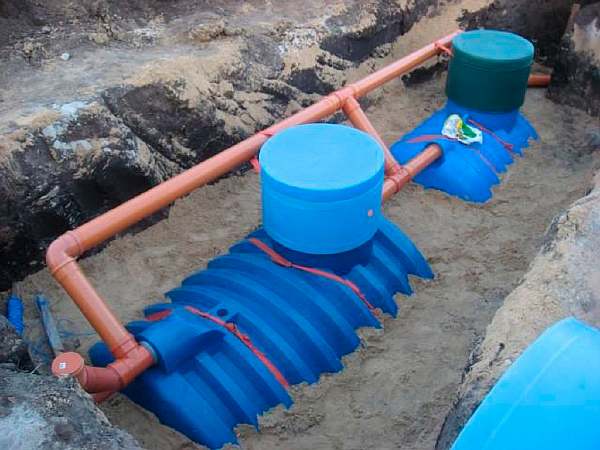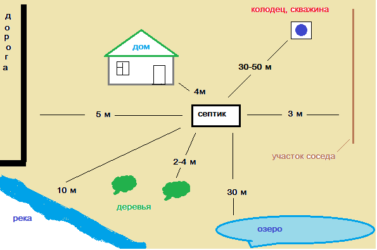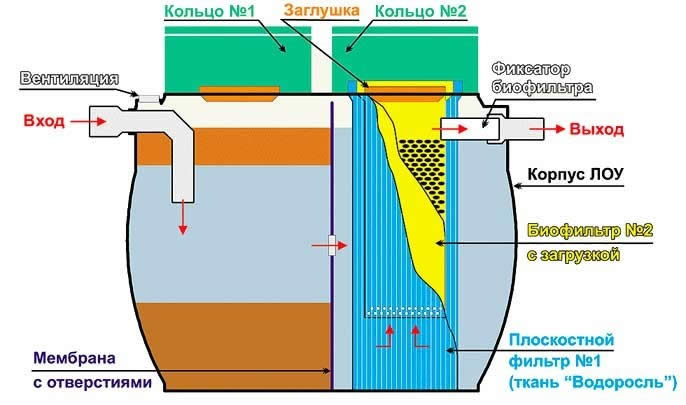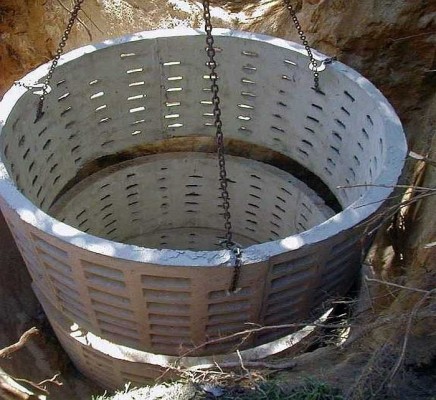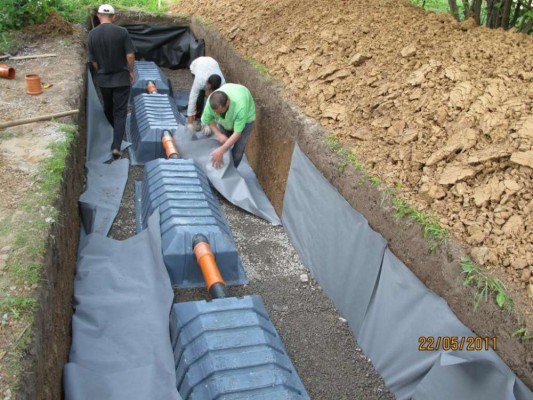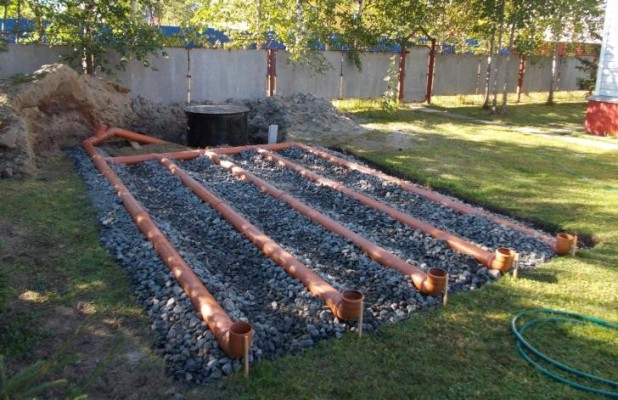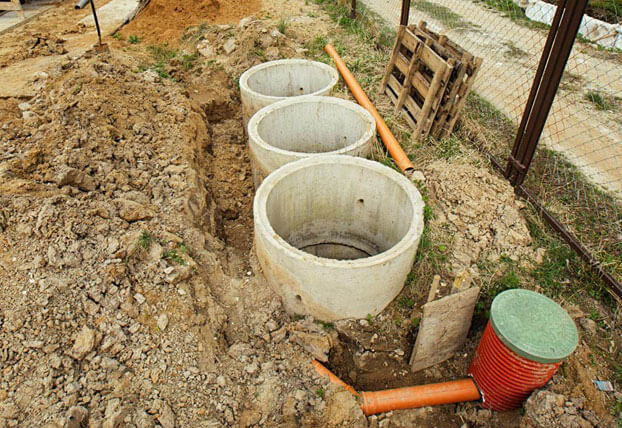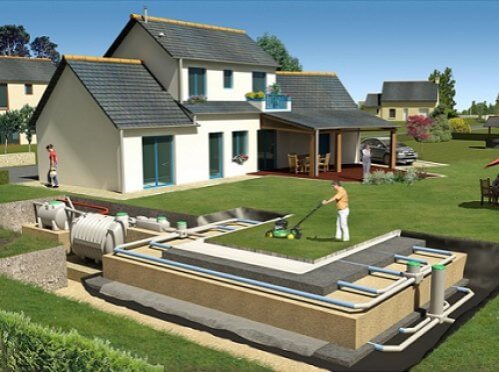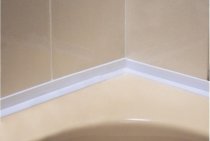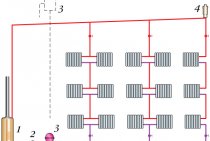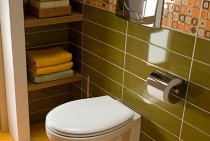Environmental measures
Recently, much attention has been paid to the protection of nature. Increased distance according to sanitary standards between sedimentation tanks and reservoirs, sources of drinking water
In the old edition, the distance from the cesspool to the well was 8 m.
Now, according to sanitary requirements, any toilet, storage septic tank and VOC can be placed no closer than 30 m from a source of drinking water. There should also be a minimum gap of 15 meters between a deep well if the thickness and density of the layer lying between them guarantees complete water purification.
Before making a fence, it is required to approve a placement plan for it. Fences higher than 1.5 meters were cancelled. Now between the plots there should be a completely transparent fence that does not obscure the gardens. Rack fences are excluded from the norm.
The distance between the septic tank and the fence is a value that requires strict observance. Sanitary and epidemiological station inspectors constantly monitor these distances both in rural settlements, towns and villages, and in cities in summer cottages. Therefore, when deciding whether it is possible to put a septic tank and how many meters to retreat from the fence and buildings, you should study all the norms of the joint venture presented above.
Good afternoon. We decided to put a septic tank, the distance to the neighbors is 1 meter, the neighbors are against it, they refer to the 30-02-97, they demand to move the septic tank no closer than 4 meters. It is legal? Are there any legal or legislative documents? Interested in links in documents at allowed distances
Lawyers' answers ( 3 )
- 9.8 rating
- 7186 reviews expert
Anastasia, good afternoon! According to clause 6.7 of the SNip 30-02-97 specified in the question
According to clause 6.8 of the same SNiP
Choosing a location for VOC
The traditional rule for many - the farther the better - does not work in this case. On the one hand, this is due to the size of the suburban area, on the other hand, the relief and groundwater level. If there is a slope on the site, then it should be located in the lowest part. At a high level of groundwater - below the aquifer, so that the latter does not become polluted. Last but not least is the length of the pipeline. SNiP recommends installation five meters from the house. Firstly, it will get rid of the unpleasant smell in the house. Secondly, it will protect the foundation from excessive moisture. Thirdly, it will reduce the cost and facilitate the maintenance of the system. The longer the pipes, the greater the likelihood of blockages, and in the event of a rush, repair is more difficult. When installing, it is necessary to take into account the slope of the pipes. The optimal difference between the upper and lower points per 1 meter is 20 - 30 mm. Not five meters, it will be 100-150 mm. Higher and lower slope increases the formation of blockages or water will not drain at all
It is also necessary to know the level of soil freezing in order to prevent freezing of the system in winter.
The correct location of the septic tank
The most difficult thing is choosing a place to install a septic tank and its correct installation, for which the minimum distance to each important element must be observed. In order to comply with all safety rules and laws for the location of treatment facilities, you should familiarize yourself with SNiP No. 2.04.03.-85
First of all, it is necessary to observe the distance from the house to the local treatment facilities, the minimum allowable is 3 meters. In some cases, if the volume of the well is large, the territory is vast and many people live in the house, the distance can increase up to 12 m. Regardless of the number of meters and the type of well, it is necessary to take into account not only your site, but also neighboring ones.In order to exclude vibration effects on the soil, a sewer well should be located at some distance from other buildings. So, for example, the distance to the road is at least 4 m, and if there is a garage on the site, then it should be taken into account.
When developing a site plan, one should take into account neighboring areas with water sources located on them, and the location of the fence. To the source of drinking water, the distance from the sewerage of the house should be from 20 to 50 meters, depending on the environmental friendliness of the drains after purification and other factors, for example, the depth of grounding. There must also be a minimum of 3 m to the water pipes so that they are not exposed to the liquid and do not corrode.
The distance to various water bodies, such as, for example, lakes and ponds, should be at least 10-30 m. This rule applies only to sewerage systems of factory models that allow you to get sufficiently clean water at the outlet. When locating a septic tank in a garden plot, it should be taken into account that the distance to fruit and vegetable plantations should be at least 3-5 meters, otherwise the roots of the trees can destroy the purification system and, moreover, take in too many unnecessary substances along with water .
In addition to the above, it is necessary to provide free passage for sewage trucks. It is worth considering that due to the large distance of the septic tank from the road, special equipment is forced to pump out from a distance of about 20-30 m, this is a very inconvenient operation. This point must be taken into account before installing all cleaning devices. The distance from the treatment plant to the fence should be at least 3-5 meters, and it is advisable to make an access road not very far from the septic tank or leave a place for sewage services.
The consequences of improper placement of a septic tank on the site
When you have decided where to install a septic tank on the site, then go straight to the SES with the finished project. Agree on the document and get approval for the construction of a sewer system.
The described rules that must be observed during construction are contained in SNiP 2.04.03-85, as well as in Sanpin 2.2.1 / 2.1.1.1200-03.
So, since there are rules for the location of a septic tank on the site that are strictly fixed in the regulations, there must be responsibility for violations of these rules. There is such a responsibility. The owner of a country house is fully responsible, including financially, for any damage caused by his sewer system to the environment. Especially if the drains got into a nearby body of water or into groundwater. After all, it is one thing to pollute your site, and quite another - if the sewage has already become a threat to your neighbors and the environment far beyond your site.
There is no escaping responsibility here. Therefore, in order not to become a malicious violator, just be careful when constructing sewers, make all the calculations as accurately as possible and do not neglect the letter of the law.
Regulations that can be found in official sources
In 1997, the Construction Norms and Rules were adopted, which are still used in the construction of residential buildings and in the placement of buildings of various types. Regarding wells, there are clear removal standards that can be used when making calculations:
from trees of medium and considerable height, the well must be at least 4 meters away (this is due to the intensive growth of a powerful root system, which can also pose a threat to concrete;
the well ring or building is removed from the bushes at a distance of at least a meter (this is what sanitary standards require so that rubbish, foliage, crumbling berries do not get into the water for drinking;
from septic tanks, cesspools, sewer systems and toilets, the well should be at least 50 m away, since closer proximity is contrary to sanitary and hygienic standards and threatens the spread of intestinal infections;
from additional reservoirs of local local sewerage, it does not matter whether they are viewing, nodal or rotary, the distance should be more than 30 m, despite the fact that they themselves should be at a distance of 15 m from each other;
a building for birds or domestic animals cannot be closer to the well by less than 30 m;
distance to the house - at least 3 meters from the foundation;
from outbuildings that do not contain animals, the well can be located at a distance of not less than 1 m.
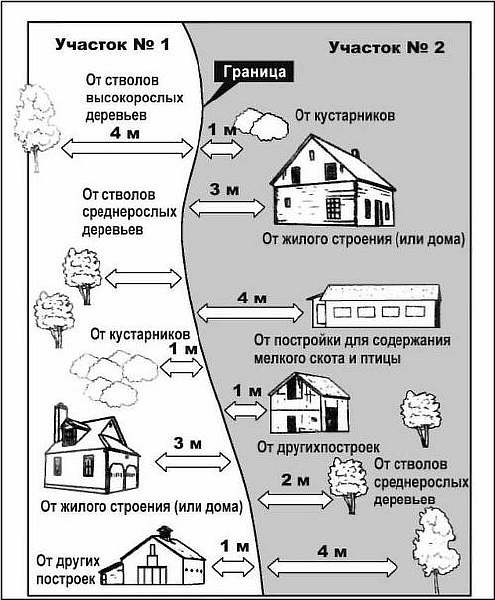
Nuances
All these standards are prescribed in the SNiP, developed for small summer cottages. A guideline for determining the optimal distance from the fence, you can choose the distance between the wells. According to the regulations, drinking water facilities can be separated by about 50 m. These rules apply both within the city and in the countryside or village for SNT, IZhS and private household plots.
But there is one relief - if they are equipped on different aquifers and the construction on one landholding does not cause a decrease in the water level in another, then the distance can be reduced to 30 m.
You can either focus on the norms for the drainage structure, then it will be 4-5 meters to the fence, or on the standard regarding the distance from the neighboring well. Then, no matter how many meters to the fence, located on an imaginary line drawn between them, the distance will be observed correctly.

If everything is endorsed by representatives of local authorities, in any disputes you can safely refer to permission received from people who are competent and have regulatory knowledge. No court will consider claims from neighbors if each building on the site has a permit issued by regional authorities.
Arbitrage practice
Litigation with a request to move a septic tank or sewer well is not uncommon. Neighbors in summer cottages and individual housing plots often go to court for help.
However, the court does not always meet the plaintiff. Since the applicant is obliged to prove that his rights, not related to the right of ownership, have been violated.
As evidence, the court accepts the conclusion of a specialized organization or the results of an examination. Moreover, in order to guarantee a positive decision, it is advisable to conduct an examination with the actual exit of a specialist to the applicant's site. Default decisions are easily challenged at the request of the defendant.
Example. Citizen V. applied to the court with a request to oblige the neighbors to move the septic tank 20 meters from her well. She used the well as a source of drinking water. And the presence of a septic tank endangers her life and health. As evidence, she attached the conclusion of a specialized organization. But the representative of the defendant disputed it, since the conclusion was drawn up without visiting and inspecting the site. The woman refused to conduct an environmental impact assessment, as it requires significant costs. The court accepted the woman's decision as a refusal of the examination. Therefore, the claim was denied.
At the same time, if the plaintiff has prepared the necessary documents, the court will oblige the defendant to move the sewer or septic tank. Also in the dispute is not the last value is the presence of official registration of residential premises.
It is the registered premises that will be considered built earlier. Therefore, such an owner has more chances for a positive decision.
Example. Citizen A. applied to the court with a request to dismantle and move the septic tank located on the neighbors' plot. Neighbors bought the site earlier, poured the foundation and put up a log house. After that, they took the septic tank away from the plaintiff. The applicant built the house later, but registered it in time. At the time of applying to the court, the defendants' housing was not registered with Rosreestr. The distance between neighboring houses was less than established by law. But the applicant coordinated the building with the administration. Thus, the septic tank was located at a distance of 1 m from the common fence. And in 4 places from the plaintiff's window. In accordance with the regulations, this distance should be at least 5 m.From the results of the examination, it followed that the septic tank needed to be moved. The court granted the plaintiff's demands.
Septic tank distance according to SNiP
As you know, a local structure is part of the sewer system and it is necessary to take a responsible approach to choosing its location.
A septic tank is a device that collects and treats wastewater from a home.
In order to avoid an unpleasant smell on the site and near the installation, it is necessary not only to choose a model whose performance corresponds to the conditions of use, but also to correctly calculate the distance from the septic tank to the house, drinking well, road, trees, fence.
Installation location according to SNiP
A place for local installation should be chosen away from a residential building, somewhere on the outskirts of the site, and if the terrain is hilly, then the choice will fall on the lowest site of the site.
In this case, the treated sewage will leave the site with the help of groundwater.
If the treatment plant is made independently or purchased, then the distance from the house to the septic tank must comply with the SNiP standards and sanitary requirements in force in our country.
The sanitary norms and SNiP requirements clearly define the location of the septic tank on the site, for example, the distance from the septic tank to the neighbor's fence, drinking well, house foundation and other norms.
In accordance with SNiP, local installations for post-treatment of water must be located at a distance of 5 meters from a residential building, and a sump can be located closer.
The layout of the septic tank relative to other objects.
Otherwise, the foundation of the building will not be protected from excess moisture.
If you want fruit and other trees not to suffer from excess water, and their roots do not rot, then the distance from planting to the treatment plant should be at least 4 m. In this case, we mean non-moisture-loving plants that can be placed near the filtration field, breaking the flower garden.
If there is no water supply in the area and water is taken from a well or a well, then (taking into account the relief) it is necessary to place a septic tank at a distance of 20 to 50 m from a drinking well or water intake. If you look realistically, summer cottages are small enough to withstand such standards, so the septic tank is located as far as possible from the place of water intake.
The installation of the treatment plant must be coordinated with the neighbors, since from an improperly located structure (if the distance to the septic tank is calculated incorrectly and does not meet the standards), this negatively affects not only the ecology of the entire site and the health of the neighbors, but also the quality of well water.
When installing a septic tank for its further functioning, it is necessary to follow the instructions for installing the device.
If an individual treatment plant is equipped on the site, then SNiP does not strictly regulate its location. But keep in mind that all work performed must be coordinated with the local administration.
Septic and neighbors
You can build a septic tank yourself. It is created from concrete rings, the seams are sealed with cement mortar and waterproofed.
If two neighboring sites are separated by a fence, then the distance from the local facility located on your site to the neighboring fence must be at least 2 meters.
It should also be noted that if the house is located in an area where a highway with frequent traffic passes nearby, then the local station should be placed at a 4-meter distance from the road.
As sediment and waste accumulate in the treatment plant, it is necessary to periodically clean it, so you should leave room for the access of a sewage truck. Since the hose of the machine can be up to 10 meters long, the septic tank must have a maximum depth of about 4 m so that the hose can reach the bottom of the station.
Modern treatment plants do not require the installation of special pumps and equipment. In order for the installation to work autonomously, it is necessary to ensure the operation of a gravity system.
This is what determines the limited gap from the pipeline to the installation, which should not be far from the house for a long distance, since in this case the local structure will have to be placed deeper than usual.
Having correctly determined the location of the local station from the house, foundation, drinking well, fence, road, reservoir, etc., the local station will be more reliable and durable. Since only professionals fully know all the norms of SNiP, it is necessary to contact specialists when starting work on installing a septic tank or conducting a sewer system.
What is a septic tank and how does it work?
Diagram of a plastic septic tank.
A septic tank is a special facility with which it is possible to collect and treat domestic and household wastewater and, often, excess rainwater if a drainage system is not installed. These wells are used for residential individual houses, small cottages and low-rise buildings. It is convenient if there is no city sewerage, the principle of operation is very similar: water is purified using bioenzymatic preparations, biofilters and soil purification methods.
There are a lot of different septic tanks for the home. If a small, small volume of wastewater, then a vertical septic tank will do. It is more difficult to mount and requires a deeper trench, but it is the best way to save square footage. To make the choice of a well easier, you must first consider how much area can be allocated for it, and then, already knowing the width and length, calculate the required depth and choose the option closest to the calculations. It is better if it is rounded up. The volume depends on the rate of water consumption per person in a given region, on the number of people and on the number of plumbing fixtures.
If possible, it is better to divide one septic tank into several sections, because with an increase in the volume of effluents, the water stagnation time also increases. If you connect two sections, then the time for passing the entire process increases by more than three times and the purification becomes much better. But then the presence of a fence can become a small problem, and in the place where the pipelines pass, you will have to remove part of the fence or make it above the ground.
Professional approach to the installation of a septic tank
Once you have decided on the location of the sewer system, you need to dig a pit and prepare trenches for pipes. An important point, the depth should be sufficient so that the pipes and the well do not freeze through in winter. If it is impossible to observe this, then simply use heat-insulating materials with which you need to cover the pipes. If this is not done, then there is a risk that the drains will freeze during the cold season, and stagnation will occur. This is fraught with both pipe breaks and a complete shutdown of the entire system.
It has already been mentioned above that it is better to build a septic tank in soft soil. But if all the soil in the area is clayey and there is no choice, then fill the bottom of such a pit with concrete. This will give stability to the storage tank, because an empty or slightly filled one may not withstand the pressure of solid soil and will undergo deformation. Do not forget to make a ventilation pipe in the sewer tank. Air exchange is necessary for the normal operation of the septic tank. Especially this rule applies to fully sealed structures with excellent waterproofing.
Post-treatment of wastewater in the ground
The location of the septic tank determines not only the type and design of the treatment device, but also the technologies used for soil post-treatment.
The absorption well is the simplest and least space-consuming device for soil post-treatment.Drains are removed into the ground through the bottom and walls of the well, which is the last section of the septic tank or the outlet of the aeration biofilter. The absorbing part of the well (bottom and perforated walls) must necessarily be located above the groundwater level (GWL) and below the depth of soil freezing. If the GWL on the site is too high, the construction of an absorption well is impossible. We recommend to remove as much as possible the source of drinking water (well, well) from the absorber. And not only his own, but also his neighbor's.
Installation of a filtration well from perforated reinforced concrete rings. Absorption of runoff by soil will be carried out both through the bottom and through the walls
The filter trench is a perforated horizontal pipe sprinkled with gravel. Clarified drains seep through the holes into the backfill, bacteria that process biological pollution live on the surface of the pebbles. The advantages of this solution: low cost, minimum excavation, the possibility of a filtration device at a high GWL. Minus: neither trees nor shrubs can be planted near the filter trench. When deepening a trench operated in winter above the level of soil freezing, it must be isolated from the surface with a layer of hydrophobic insulation. Expanded polystyrene, expanded clay is suitable.
The length of the trench is calculated based on the volume of drains and the presence of ventilation
An analogue of a filter trench with an increased volume of backfill and protected from atmospheric influences. If the infiltrator is provided with a ventilation outlet to the surface and thereby ensures air flow into the trench, the organics processing process can be intensified. The device can be located both below and above ground level, partially or fully. This solution is used at very high GWL in combination with an aeration tank with forced pumping of wastewater, when other systems are not suitable. The pipe and backfill are closed from above with a polymer “lid”, if necessary, insulated and covered with soil. An earthen mound overgrown with grass remains on the surface.
The infiltrator can be multi-section
In fact, the filtration field is a system of branched filtration trenches. Due to the long length of the pipes, the best wastewater treatment is achieved. Planting a garden over pipes is not allowed. By the way, magnificent lawns in front of private houses in America are broken just above the filtration fields, because 95% of houses in North American towns are equipped with local sewer systems. Filtration fields are inexpensive in warm climatic conditions, but arranging them in areas with a large depth of soil freezing is not so profitable, the amount of excavation is too large.
The filter field is a good thing, but it takes up a lot of space
Septic tank options for the site
To answer the question of where to place a septic tank on the site, first let's figure out what systems exist today for these purposes.
First of all, they are:
- Monolithic. when the sewer tank fully meets the requirements of waterproofing and it does not need to be further treated from the inside with bitumen or cement mortar.
- teams. Such systems will have to be subjected to a thorough waterproofing process, because there will be joints and gaps. As a rule, this kind of septic tank is not easy to install and it takes a lot of time.
Also, septic tanks differ in the material of which they are composed.
- Brick,
- metal or plastic containers,
- Concrete or concrete rings
According to its principle of operation, septic tanks can be divided into the following types:
- Cumulative (their function is just the collection of wastewater).
- Treatment. They contain bioactivators that purify and filter incoming effluents. This is convenient because the resulting water can be reused. For example, for watering crops.
- With soil filtration system.Such septic tanks also perform the function of wastewater treatment and release the resulting water into the ground.
Depending on how deep your septic tank will be located, they are divided into:
By the way, septic tanks can be placed not only underground, but also on the surface. This again depends on the properties of the soil and the height of the groundwater. Therefore, it is not always possible to bury septic tanks in the ground. Although, it is obvious that on the surface - the view of the reservoir somewhat spoils the picture of the site.
Perhaps one more gradation can be distinguished:
- Volatile septic tanks requiring connection of their system to the mains.
- Autonomous. working without electricity. And this, in general, is convenient.
About distances and sizes
We are planning a site
Filtration field, septic tanks and wells. Placement principles that do not violate the general rules of operation.
The distance from the house to the septic tank can be any, at any point in the plots, if the devices are airtight. Even right behind the blind area. Ventilation of the sump becomes the only limitation in this case. So are the smells associated with this design. But, if you approach the issue correctly, you can lay pipes with a constant slope anywhere.
A minimum distance of five meters to windows and doors is recommended to be maintained if the ventilation is taken out directly above the septic tank. The prevailing wind direction deserves special attention during planning.
- Filtering wells are located no closer than the same five meters from the foundation. Otherwise, the water that passes through the soil will wash the foundation, due to which its life is reduced. The filtration types of the well and the field are located below the house along the slope, if the site itself has a slope. This is necessary for the safety of the structure. The distance from the house to the septic tank also helps to ensure safety.
- 50 meters - the minimum distance between the septic tanks and the well. This refers not to their filtering variety, but to devices for water intake. A large number of anaerobic bacteria live in the soil. At other distances, they simply do not have time to carry out a complete cleaning of the product.
Anywhere it is allowed to place a water intake from the lower aquifers, if the casing is securely sealed. The main thing is that there should be no communication between the aquifers from above and below.
